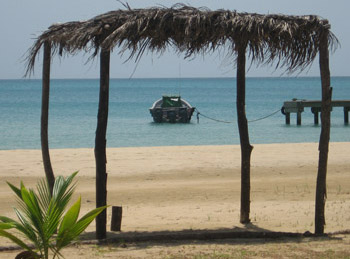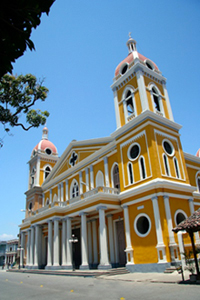NICARAGUA - THE LAND OF LAKES AND VOLCANOES

About Nicaragua
What can one say about Nicaragua? Well, until recently there was not much said that was positive. Even though I am of Nicaraguan descent, I had no desire to visit Nicaragua due to all the political issues. Both my parents were from Nicaragua. My father was born in Masaya and my mother was born in Chinandega. As a child, I lived a few years in Managua and left before the earthquake devastated what was once the most cosmopolitan city in Central America. Unfortunately, I was too young to remember anything about Nicaragua and I returned to the United States not really having any recollection about the land of my ancestors.
What A Difference Time Makes
Many years have passed since my childhood and I have since started a family of my own. I wanted to instill with my children a sense of pride and ancestry. When I started hearing that the situation was getting better in Nicaragua I thought maybe it was time to go back. Many family members were going down to Nicaragua and coming back with wonderful stories of how much fun they had and of the natural beauty of the country. Even my wife, who is not Nicaraguan, began having a desire to visit Nicaragua. She was instrumental in our family finally making the trek to Central America. I was able to share with my wife my heritage and to have my children experience the land of their abuelos. So after many years, I was back in Nicaragua, not knowing what to expect but excited to finally get to know the Land of Lakes and Volcanoes.
The Land of Lakes and Volcanoes
As an adult, my experience of Nicaragua with my family has changed me forever. I discovered a land full of beauty and wonder. Yes, there is much poverty and the infrastructure is not where it needs to be but in my opinion, Nicaragua has so much to offer, more so than some of the more 'popular' vacation destinations in the area. Nicaragua has two large in-land lakes. The largest one is Lake Nicaragua, also known by its indigenous name Lago Cocibolca. It is the largest lake in Central America. Within the lake you'll find the island of Ometepe which has been idenitifed as one of the world's natural wonders. It consists of two volcanoes, Concepción and Maderas. Lake Nicaragua is the only place on earth that has fresh water sharks. As far as volcanoes, Nicaragua has over fifty, most of them are dormant but none the less spectacular. Some of them are filled with water, creating natural lagoons like the Laguna de Apoyo, near the artisan town of Masaya.
The Rain Forrests and the Caribbean

Nicaragua is also home to 78 protected areas covering over 20% of it landmass,
and is home to 7% of the world's biodiversity, more than Costa Rica. Nicaragua
is also home to Bosawas, located in Northern Nicaragua, which is the largest rainforest
north of the Amazon in Brazil!! On the Caribbean side of Nicaragua you'll find an entirely different
culture. Whereas the population on the Pacific side is more influenced by the
Spanish, the inhabitants on the Caribbean side are mostly ancestors of African slaves.
Instead of Spanish, you'll mostly encounter languages such as Creole, Miskito and English.
The main town of Bluefields was named after Dutch pirate Abraham Blauvelt.
Off the shores of Bluefields, 70 km northeast, you'll find the beautiful Corn Islands.
Big Corn Island and Little Corn Island are lush with exotic fruit trees, native palms
and surrounded by white sand beaches. Once a haven for pirates and buccaneers in the 17th century,
there are untold numbers of shipwrecks and treasures that still lay scattered
along island's turquoise shores.
The Colonial Cities
Besides all the natural beauty, Nicaragua is also home to two of the oldest Spanish colonial cities in the western hemisphere, León and Granada. León is the second largest city in Nicaragua, after Managua. León was the capital of Nicaragua until 1857. Originally, the city lay at the foot of Volcán Mombotombo, but was moved to its current location in 1610 after an earthquake and volcano eruption destroyed the old city. The ruins of the abandoned city are known as "León Viejo" and were excavated in 1960. In the year 2000, León Viejo was declared an UNESCO World Heritage Site. León has fine examples of Spanish Colonial architecture, including the grand Cathedral of the Assumption which took more than 100 years to complete from 1747-1860. It is the largest cathedral in Central America. There are many graves under the cathedral and the most spectacular grave is that of Rubén Darío, the most famous Nicaraguan poet, whose tomb is covered by a stone lion in the center of the church. León also has long been the intellectual center of the nation, with its university founded in 1813.

Granada is the other colonial jewel, nestled off the shores of Lake Nicaragua. It has a rich colonial heritage, seen in its architecture and layout. Granada is commonly nicknamed the "Gran Sultana del Gran Lago" - the Great Sultan of the Great Lake. Granada is historically one of Nicaragua's most important cities both economically and politically. Granada's economy continues to grow as it is becoming the national tourism hub. Though Granada remains Nicaragua's fourth largest city, it is widely known for preserving some the finest colonial-era architecture in the country. It is much more colorful then León and thanks to the influx of foreign investors, many of the old colonial homes have been renovated to their full colonial glory. Granada was historically the Central American sister capital to Antigua, Guatemala. You'll recognize the similarity in towns design, colors and architecture. New museums have opened, including one of the finest in the country, the private Mi Museo. There are a variety of new hotels and restaurants to service tourists which Granada has grown dependent on. One of the highlights of any trip to Nicaragua is a ride through the streets of Granada in a horse drawn carriage. You can also ride down to the lake where you can get on a boat to explore Las Isletas just offshore, a beautiful archipelago of volcanic origin. Some of the 365 islands are inhabited and most are covered with a vast variety of unusual vegetation.
